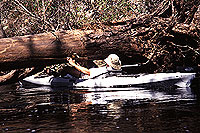|
History Animals & Plants Natural Communities Management Management Goals Management Tools References |
Natural Communities Management:
Management Goals
What comes to your mind when you read the word “land?” Deep forests? Rolling pastures? Deserts? Cities? Landfills? Real estate signs?
Land means something different to each one of us. Part of the reason is that land can serve so many different purposes: tree plantations, subdivisions, farms, shopping malls, high-rises, campgrounds, wildlife habitats, garbage dumps, baseball field... the list is nearly endless.
Managers of natural communities on public lands set their goals according to the purpose for which the land was acquired by the government. Some are very specific; some are very broad. Private lands are managed at the discretion of the owner, within some legal limits.
Every manager must balance immediate demands with the interests of future generations. The word “sustainable” is heard in most land management discussions, although its exact meaning may be elusive.
Management aiming at a relatively narrow goal can also be good for other purposes. For example, managing for water quality can create good habitat for fish and other aquatic animals. But management may sometimes also work the other way. Emphasizing recreation can disturb sensitive species; plants get trampled and animals get driven off by excessive noise. Like many things in life, land management involves trade-offs.
Some of goals of land management include:
 Dead trees, also known as snags, are important to many wildlife species. (photo by Karla Brandt) |
Water quality can be protected by keeping contaminants out of the water. In the ARROW region's karst plains (see Geology section), the ground surface is linked directly to the drinking-water supply. Any liquid that hits the ground will end up in the underground water supply. These areas are called “recharge zones” because the underground supply is “recharged” from rain that falls there. Such areas should be managed with extreme care to prevent contamination of the water. Other land-management considerations to protect surface water quality in water bodies such as wetlands, sinkholes, ponds, lakes, and rivers include preserving vegetation in buffer zones around these water features to prevent erosion and to filter runoff from upland areas; fencing to keep grazing livestock from contaminating the water; and providing wide setbacks between surface water features and highways, parking lots, and other sources of polluted runoff. The Florida Division of Forestry's Best Management Practices are meant to protect water quality during forestry operations (see www.fl-dof.com/Conservation/hydrology/index.html).
Forest products include pulp, which is used to make paper products; mulch for landscaping; and, of course, lumber. Other products that contain chemicals derived from wood include textiles, chewing gum, fungicides, linoleum, nail polish, ketchup, and ice cream. Growing trees requires knowledge of soils and what kinds of equipment can be used on the soil without damaging or destroying the soil structure; the requirements of various tree species for light, nutrients, and water; the role of fire; optimum tree spacing; market forecasts for forest products; and law. See the Silviculture page at www.sfrc.ufl.edu/Extension/ffws/silv.htm.
 Laid back in a kayak on the Sopchoppy River (photo by Karla Brandt) |
Restoration can be done on many scales, from cleaning up trash on a wooded road to recreating entire ecosystems. One of the most ambitious restoration projects in the ARROW region is currently taking place at the privately owned Apalachicola Bluffs and Ravines Preserve north of Bristol. The Nature Conservancy (TNC) purchased the property to save the ravines that trickle into the Apalachicola River, which are home to many rare species and to plant communities more typical of northerly mountains than of Florida. TNC staff have moved the earth (literally) to turn a slash pine plantation back into the community that was there before: a longleaf pine sandhill, complete with a lush and diverse carpet of grasses and flowering herbs, and someday with fox squirrels, gopher tortoises, and black bears. Perhaps the children of the Preserve's stewards can show their children the forest their grandparents brought back to life.
Multiple use is the goal of the U.S. Forest Service, which manages the Apalachicola National Forest. It is a legal mandate for the Forest Service, requiring the managers to balance “multiple use” of its lands. Managers must figure out how to balance demands for wood products, recreation, aesthetics, watershed protection, habitat for fish and wildlife, and historic and cultural preservation. “The mission of the USDA Forest Service is to sustain the health, diversity, and productivity of the Nation's forests and grasslands to meet the needs of present and future generations.” www.fs.fed.us/aboutus/mission.shtml
Because some land uses are incompatible with other land uses, the process of planning multiple-use management can be likened to juggling a nearly infinite number of flaming torches. Plans must take into account the capability of the land, what the public wants now, and what the public may want in the future, legal requirements and constraints, and the agency's budget.
Note: The content of the website has not been updated since 2005. The site remains online for it's value as legacy content and is unlikely to be updated.